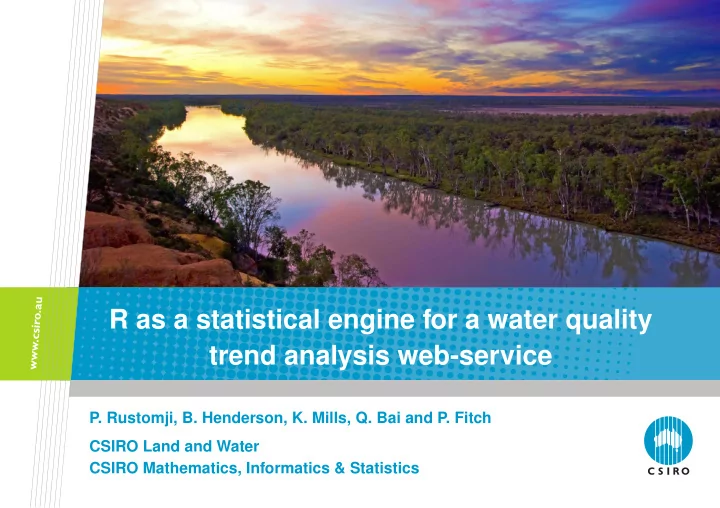

R as a statistical engine for a water quality trend analysis web-service P. Rustomji, B. Henderson, K. Mills, Q. Bai and P. Fitch CSIRO Land and Water CSIRO Mathematics, Informatics & Statistics
Motivation Improve water quality condition and trend reporting in Australia by: • harvesting existing statistical methods for water quality trend analysis • assessing compliance or progress towards targets and guidelines and • presenting these in a robust, scientifically supported and web-accessible tool.
Why is this important? • Multiple trend analysis methods applied by States/Territories (or consultants) but they are not broadly available or presented in ways that makes adoption and regular use easy. • A need to provide more robust and routinely available picture of water quality conditions. • Assist in directing future investment in land and water management. • Build awareness of the challenges and complexities in linking management actions with identifiable and desired environmental response.
Trend Analysis Methods considered • Seasonal Kendall’s Tau slope estimate (Theil/Sen estimate) – non-parametric estimate of slope – related to Seasonal Kendall’s Tau tests for monotonic change – flow adjustment possible but two step procedure • Linear Regression & Generalised Additive Models – flexible framework for trend analysis that allows us to adjust for covariate effects – Linear time trend → linear regression – Nonlinear trend → GAMs (uses smoothing splines) log( EC i ) = β 0 + β 1 log( flow i )+ β 2 sin(2 πt i )+ β 3 cos(2 πt i )+ β 4 t i + s ( t i,d f )+ ǫ i response flow effect seasonal cycle linear non linear
Example
What We Did Provide a web service that performs trend analyses of water quality data, using R as the statistical engine for analysis and visualisation • Microsoft .NET is used to construct the web service • Text files for data and parameter input • Server calls R scripts using Rscript.exe • Analysis is contained within Sweave files – Report template in L A T EX interspersed with R code • Sweave’d files (*.tex) are compiled using pdflatex.exe to produce a pretty PDF report • PDF graphics files converted to PNG format using Ghostscript • User can download data and graphs.
Advantages: 1. Makes R available to a larger audience (no direct R programming experience required). 2. Reference R objects in report using Sweave Sexpr {} . 3. Include interpretative statements tailored to the statistical results EX ifthenelse package in conjunction with Sexpr {} (using the L A T statements) e.g. “The flow adjusted linear trend is -14.45 units change per unit time. The significance level (p-value) for this trend is < 0.001 which means the likelihood of such a trend occurring by chance is less than 1 in 1000.” 4. Harness typesetting capabilities of T EX to produce a high quality PDF report. 5. Access mapping capabilities of GoogleMaps. 6. Internet-wide accessibility. 7. Can be called by other applications (e.g. from Microsoft Excel).
C:/>rscript.exe %WQSAR_SCRIPT_PATH%\\mastertrend.r \path\to\output_dir\1234 --slave ---- contents of mastertrend.r ---- outpath <- commandArgs(TRUE) #first and only argument is the path to the output directory} uniquenum <- basename(foo[1]) #get last part of directory name par.file<- paste(uniquenum,"parameter_file.txt",sep="-") #parameter_file name inputfile <- paste(uniquenum,"single_file.csv",sep="-") #data_file name sp <- Sys.getenv("WQSAR_SCRIPT_PATH") #path to code #read in input parameter file f <- function(.file){source(.file,local=TRUE);as.list(environment())} ipf <- f(par.file) #now call the Sweave files that actually do stuff.... try(Sweave(paste(sp,"\\routines\\BEGIN_ROUTINE.Rnw",sep=""), output=paste(uniquenum,"-BEGIN_ROUTINE.tex",sep=""),debug=FALSE,quiet=FALSE)) if(ipf$gam.method == TRUE){ #if GAM analysis was chosen... try(Sweave(paste(sp,"\\routines\\GAM_method.Rnw",sep=""), output=paste(uniquenum,"-GAM_method.tex",sep=""),debug=FALSE,quiet=FALSE)) } if(ipf$lin.method == TRUE){ #if linear regression was chosen...etc try(Sweave(paste(sp,"\\routines\\LINEAR_method.Rnw",sep=""), output=paste(uniquenum,"-LINEAR_method.tex",sep=""),debug=FALSE,quiet=FALSE)) } ---- end mastertrend.r ---- ::NOW MERGE OUTPUT FILES READY FOR PDFLATEX COMPILATION C:/>copy /Y latex-preamble1.tex /A + 1234-BEGIN_ROUTINE.tex /A + 1234-data_summary.tex /A + 1234-LINEAR_method.tex 1234-GAM_method.tex /A + 1234-NONPAR_method.tex /A + 1234-END_ROUTINE.tex /A %uniquenum%-%fileend%.tex :: then compile... C:/>pdflatex.exe --quiet --job-name=%uniquenum%-%fileend% "%uniquenum%-%fileend%.tex" ::Voila!
Acknowledgements CSIRO’s Water for a Healthy Country Flagship, Australian Government’s Caring for our Country program, the Bureau of Meteorology and the Northern Australian Sustainable Yields project. Plus lots of R and L A T EX packages . . . SIunits RWinEdt gam lastpage stats longtable booktabs xtable RColorBrewer methods boot Sweave lscape latexsym gswin23c ifthen nlme boxedminipage RGoogleMaps arev geometry ccaption fancyhdr
CSIRO Land and Water CSIRO Mathematics, Informatics & Statistics Paul Rustomji Phone: +61 2 9710 6915 Email: paul.rustomji@csiro.au Web: wron.net.au/WebApps/WQSARPortal/Home.aspx Contact Us Phone: 1300 363 400 or +61 3 9545 2176 Email: enquiries@csiro.au Web: www.csiro.au
Recommend
More recommend